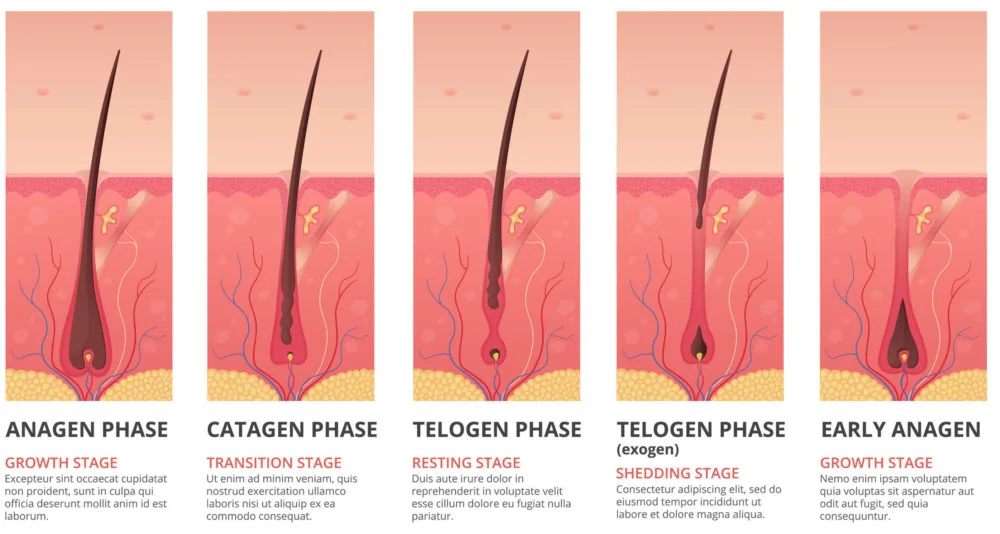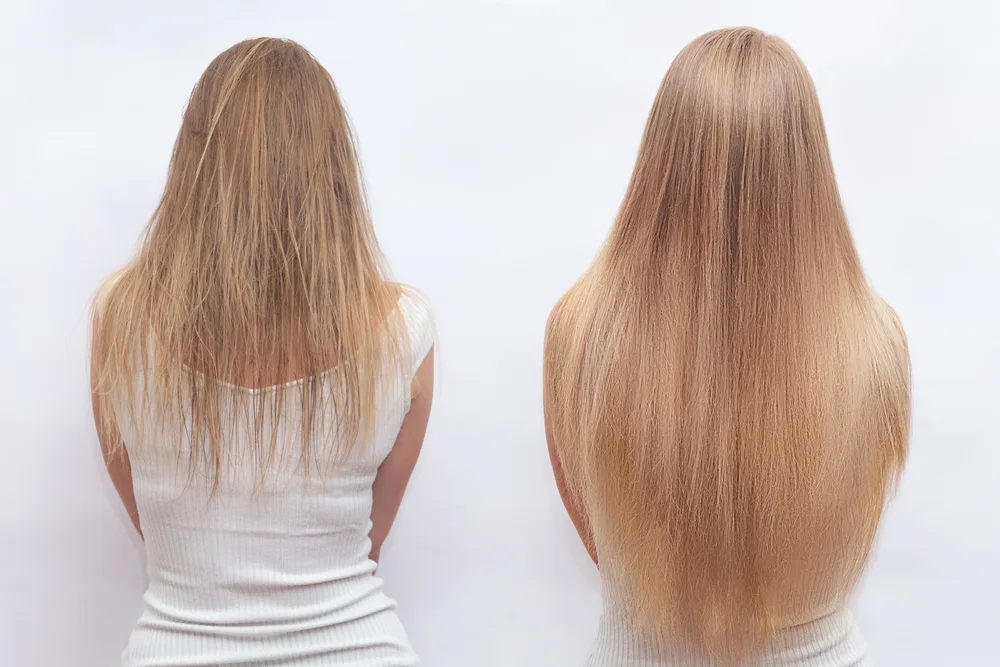Jump to:
Experiencing hair loss and subsequent pattern baldness is a nightmare for anyone. Unfortunately, millions worldwide suffer from this unfortunate experience of hair fall, compelling them to take measures to regrow lost hair.
But how do you know if you are on the right track to induce new hair growth? Don’t worry — we’ll discuss the most common new hair growth signs to encourage you in your journey toward a head full of hair again. Read on to learn more!
What Is New Hair Growth?

Onyxprj/Shutterstock
New hair growth refers to the anagen phase of the growth cycle, during which the division of cells in the hair root induces active growth. As a result, the new hair appears strong and shinier with minimal breakage.
Hair loss can occur due to various reasons. Physiological changes like aging lead to hair fall, with the most common causes including hormonal changes, hereditary traits, and underlying disorders.
Autoimmune disorders like androgenetic alopecia commonly cause hair thinning and weakening, eventually leading to hair loss. Inducing new hair growth when suffering from alopecia or hereditary reasons can be arduous.
If you are actively striving to regrow your hair, you might be perplexed as to what new hair growth is or what it looks like. You can notice different stages of the new hair growth cycle, which include the:
Anagen Phase
This phase is marked by the initial development of the hair follicles. When optimally hydrated, the hair strands grow, and you will notice 90% of the hair growth during this phase. This phase lasts for about 3-10 years.
Catagen Phase
This phase is a transitory period characterized by slowed-down hair growth, lasting one to two weeks.
Telogen Phase
This phase is the resting phase, where there is no hair development, and the hair maintains its size. It lasts 2- 4 months.
Signs of New Hair Growth
It goes without saying that all victims of hair loss desire rapid new hair growth. A 2022 study revealed that almost half the candidates suffered from alopecia. Hair regrowth is possible with various strategies, including lifestyle modifications and hair regrowth products.
Knowledge about spotting new hair growth signs keeps you motivated to continue the haircare routine and achieve a scalp with full, thick, and healthy hair. The following are some subtle yet noticeable signs indicating new hair growth:
1. The Appearance of Dark Spots (A Shadow)
Growth of a new hair follicle begins with small dark spots on the scalp or the other parts of the skin. You must check the skin and scalp under good lighting to identify them.
These dark spots on the scalp can be the ray of hope for those suffering from pattern baldness (androgenetic alopecia). The dark spots are referred to as a shadow. The shadow is seen in the proliferative phase when the follicle is nourishing.
These dark spots convert into grown hair shafts in the anagen phase. Re-epithelialization occurs during the anagen phase, which promotes the strengthening of the hair.
2. Fuzz
The most evident sign of new hair growth is vellus hair, also known as peach fuzz. Vellus hair refers to short, fine hair that you can notice on different body parts.
These hairs are most notable on the facial region but can also grow on the arms, legs, and stomach. Peach fuzz indicates new hair growth. This type of hair is thinner and softer than the rest and appears translucent.
Such hair is noticed after the transplant surgery and is considered a marker of the success of the surgery. You may have noticed peach fuzz on babies. So, baby hair indicates new hair growth.
Read Next: How to Tame Baby Hairs in 6 Simple Steps
3. Fine and Short Hair
The baby hair strands sprout and are finer than your previous, weak hair. A healthy scalp will lead to the significant growth of new hair. Research shows that the texture of the hair after chemotherapy-induced hair loss is finer than before.
Strands of the baby vellus hairs (peach fuzz) are generally finer but short in length. We recommend you be extra conscious in combing them as they break off with excessive force (brushing and scratching). The fine hairs appear silkier and more attractive.
4. Reduced Hair Breakage/Fall
Alopecia and aging speed up the process of hair fall. Weak hair falls off even with the slightest pressure. You may notice a bunch of hair fall while showering. New hair growth is characterized by reduced breakage and fall.
The best part of new, regrown hair is its strength. In most cases, hair loss results from hair thinning and weakening. Diseases like male pattern baldness make hair thin and prone to breakage. The dry and brittle hairs break, and hair strands are damaged from the roots.
But this is not the case with new hair. Regrown hair has stronger roots and shafts. So, if you find your hair to be growing and experience minimal breakage, be sure that these are new ones!
5. More Shine
If you find an increase in the radiance of your hair, it is an encouraging sign of new hair growth! New hairs are shinier and more healthy. The abundance and improved texture of the hair impart a shinier look that will surely increase your attractiveness.
Read Next: How to Easily Get Shinier Hair at Home
6. Stronger Hair
Needless to say, the new hairs are stronger instead of appearing dry and lifeless than the previous hair. Many individuals worldwide shave their heads in an attempt to regrow stronger hair.
New hair appears stronger with more volume and length. We suggest you be patient and not rush into testing the hair strength.
That is because the initial signs of hair growth are short and fine hair. It takes some time for the vellus hair to become active and gain volume. After that, the thick, regrown hair is stronger and more resilient.
7. No Split Ends
Many people, especially women, are frustrated over the split ends of their hair. A split end is considered a sign of an unhealthy hair strand. Hairs with split ends do not grow or increase in length and volume.
According to a study, the following features are present in healthy hair:
- Shine
- Clean-cut ends
- Smooth texture
If you detect fewer split ends, you have likely achieved new hair growth. However, maintaining your healthy, newly grown hair requires following a proper hair care routine.
8. Easily Manageable Hair
The silky, strong, and robust new hair is resistant to tangling and breaking off. Individuals suffering from hair loss disorders (alopecia) must be extra conscious when combing and styling their hair.
The new, soft hair can remove the hassle of managing weak strands. Easy management of new hair on a healthy scalp rejoices men and women of all ages. Brushing and styling hair is easier than ever.
How Can I Grow Hair Fast?

Steklo/Shutterstock
Below are some simple yet effective strategies to boost hair growth.
Drink Ample Water
Staying hydrated improves your skin and hair health. According to a study, dehydration can promote hair loss (especially in children). Keeping the scalp hydrated encourages healthy hair growth. Regrown hair is stronger and silkier.
Scalp Massage
Massaging the scalp has proven to be an effective method in the regeneration of new hair. According to a study, scalp massage activates the dermal papilla cells (skin cells). Applying different natural products to your scalp promotes new hair growth.
These include:
- Aloe vera
- Rose water
- Coconut oil
- Rosemary oil
- Geranium oil
- Lemon juice
- Onion juice
Take Supplements
Dietary supplements have also shown promising results in amping up new hair growth. You can add the following supplements to the diet for increased hair growth:
Multi-Vitamins
Research shows that minerals and vitamins are essential in halting hair loss and promoting hair growth. For example, vitamins A, B complex, and C can speed up hair regrowth by rejuvenating the scalp and reducing oxidative stress.
Vitamin D plays a crucial role in hair follicle cycling, thus, altering the rate of hair reproduction and stimulating new growth. Therefore, it is suggested for patients with alopecia.
Read Next: Which Vitamins Are Best for Hair Growth?
Biotin and Collagen
Consuming biotin and collagen in dietary supplements can enhance hair regrowth. There is evidence that oral biotin supplementation improves hair production. Similarly, collagen supplementation is beneficial for the skin, hair, and scalp.
Read Next: How Long Does Biotin Take to Work?
Minerals and Herbs
Minerals (zinc and selenium) and herbs such as ginseng aid in new hair growth.
Acupuncture
Traditional Chinese medicine (TCM) can be a beneficial step in triggering new hair growth. A study highlighted that acupuncture promotes cytokine expression; therefore, you can use it in treating hair loss.
Introducing fine needles into the scalp improves scalp health and effectively prompts the dermal cells to produce new hairs.
Read Next: Does Microneedling Work for Hair Loss?
Frequently Asked Questions

Maidannikov/Shutterstock
Below is a list of some frequently asked questions regarding www hair growth.
How do you know new hair is growing?
You can notice different signs that indicate the growth of new hair. The first sign of new hair growth is the appearance of dark, black spots known as shadows. The new hairs are baby strands, i.e., peach fuzz. The vellus hair is short but strong. You may also notice your hair to be shinier with minimal breakage.
Can you feel when your hair is growing?
The process of new hair growth is slow and steady, so noticing it is not possible. You can feel short vellus hair by rubbing your hands on the scalp now and then. Only after some time can you note an increase in hair volume. However, there are no physical sensations that indicate hair growth.
How long does it take to notice new hair?
New hair growth following medicinal treatment (topical) and hair transplants may take a few months. Generally, it takes around four to six months to notice the growth of new hair follicles. That is because the initial, small hair is unnoticeable, and it takes at least three months for the hair shafts to reach an appreciable length to be noticed.
Does itching mean your hair is growing?
Itching on the scalp can result from several conditions, including dermatitis, yeast infection, and dandruff. Many believe that itching indicates new hair growth, but that is not true. It is the opposite. Scalp itchiness can negatively impact your scalp health and hair regrowth.
How can I make my hair grow faster?
You can amplify the process of hair regrowth in several ways. For example, oil massage of the scalp with essential oils, following a good hair care routine, taking dietary supplements, and drinking copious amounts of water can keep the scalp healthy, inducing faster hair growth.
So, What Are the New Hair Growth Signs?
Hair fall is a common disorder that affects individuals of all ages. As a result, millions of people across the globe spend hundreds and thousands of dollars on invasive and noninvasive treatments to trigger new hair growth.
You can improve the rate of hair growth by massaging your scalp to increase blood circulation, taking dietary supplements, following a proper hair care routine, and drinking loads of water daily. Happy growing!
